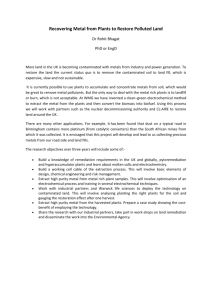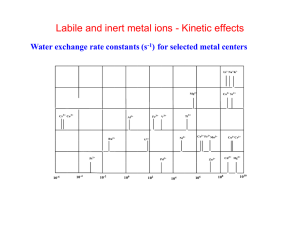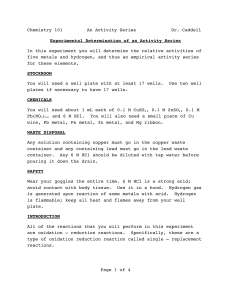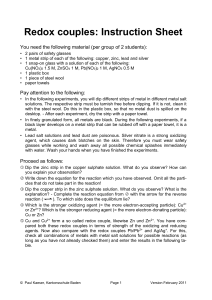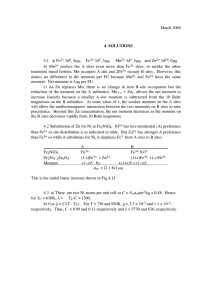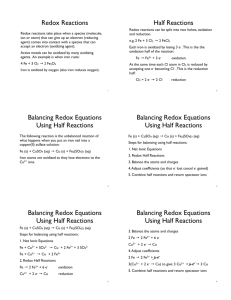chapter18problems.16..
advertisement
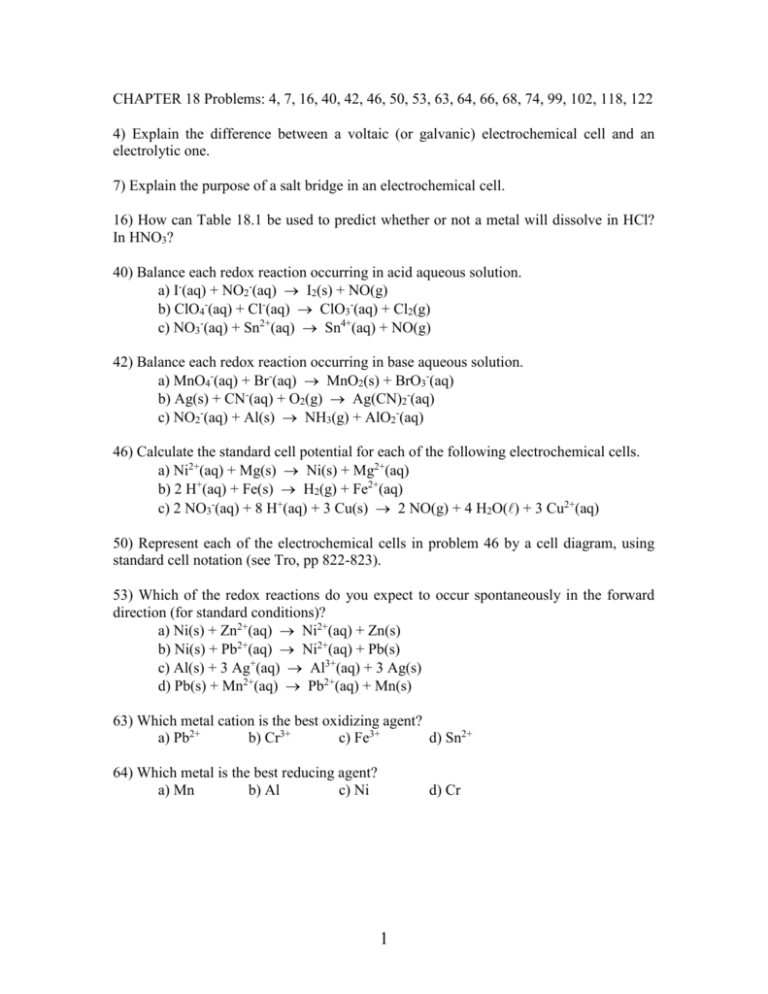
CHAPTER 18 Problems: 4, 7, 16, 40, 42, 46, 50, 53, 63, 64, 66, 68, 74, 99, 102, 118, 122 4) Explain the difference between a voltaic (or galvanic) electrochemical cell and an electrolytic one. 7) Explain the purpose of a salt bridge in an electrochemical cell. 16) How can Table 18.1 be used to predict whether or not a metal will dissolve in HCl? In HNO3? 40) Balance each redox reaction occurring in acid aqueous solution. a) I-(aq) + NO2-(aq) I2(s) + NO(g) b) ClO4-(aq) + Cl-(aq) ClO3-(aq) + Cl2(g) c) NO3-(aq) + Sn2+(aq) Sn4+(aq) + NO(g) 42) Balance each redox reaction occurring in base aqueous solution. a) MnO4-(aq) + Br-(aq) MnO2(s) + BrO3-(aq) b) Ag(s) + CN-(aq) + O2(g) Ag(CN)2-(aq) c) NO2-(aq) + Al(s) NH3(g) + AlO2-(aq) 46) Calculate the standard cell potential for each of the following electrochemical cells. a) Ni2+(aq) + Mg(s) Ni(s) + Mg2+(aq) b) 2 H+(aq) + Fe(s) H2(g) + Fe2+(aq) c) 2 NO3-(aq) + 8 H+(aq) + 3 Cu(s) 2 NO(g) + 4 H2O() + 3 Cu2+(aq) 50) Represent each of the electrochemical cells in problem 46 by a cell diagram, using standard cell notation (see Tro, pp 822-823). 53) Which of the redox reactions do you expect to occur spontaneously in the forward direction (for standard conditions)? a) Ni(s) + Zn2+(aq) Ni2+(aq) + Zn(s) b) Ni(s) + Pb2+(aq) Ni2+(aq) + Pb(s) c) Al(s) + 3 Ag+(aq) Al3+(aq) + 3 Ag(s) d) Pb(s) + Mn2+(aq) Pb2+(aq) + Mn(s) 63) Which metal cation is the best oxidizing agent? a) Pb2+ b) Cr3+ c) Fe3+ d) Sn2+ 64) Which metal is the best reducing agent? a) Mn b) Al c) Ni d) Cr 1 66 + 68) Use tabulated electrode potentials to calculate Grxn for each reaction at 25. C. Then calculate the equilibrium constant for each reaction. a) 2 Fe3+(aq) + 3 Sn(s) 2 Fe(s) + 3 Sn2+(aq) b) O2(g) + 2 H2O() + 2 Cu(s) 4 OH-(aq) + 2 Cu2+(aq) c) Br2() + 2 I-(aq) 2Br-(aq) + I2(s) 74) A voltaic cell employs the redox reaction 2 Fe3+(aq) + 3 Mg(s) 2 Fe(s) + 3 Mg2+(aq) Calculate the cell potential at 25. C under each set of conditions a) standard conditions b) [Fe3+] = 1.0 x 10-3 M; [Mg2+] = 2.50 M c) [Fe3+] = 2.00 M; [Mg2+] = 1.5 x 10-3 M 99) Copper can be electroplated at the cathode of an electrolytic cell by the half reaction Cu2+(aq) + 2 e- Cu(s) How much time would it take for 325. mg of copper metal to be plated at a current of 5.6 A? 102) What mass of aluminum metal can be produced per hour in the electrolysis of molten aluminum salt (containing Al3+ ion) by a current of 25. A? 118) The Ksp of Zn(OH)2 is 1.8 x 10-14. Find Ecell for the half reaction Zn(OH)2(s) + 2 e- Zn(s) + 2 OH-(aq) 122) A metal forms from the fluoride compound MF3. Electrolysis of molten MF3 by a current of 3.86 A for 16.2 minutes deposits 1.25 g of metal. What is the molar mass of the metal? 2


